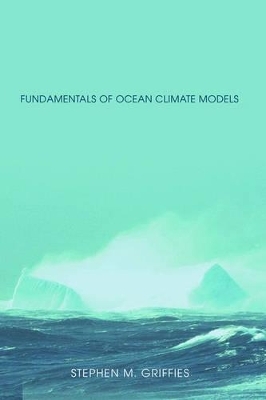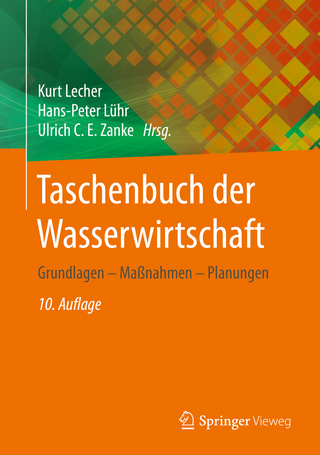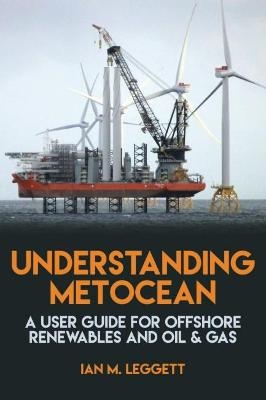
Fundamentals of Ocean Climate Models
Princeton University Press (Verlag)
978-0-691-11892-5 (ISBN)
The book proceeds to focus on the parameterization of phenomena occurring at scales unresolved by the ocean model, which represents a large part of modern oceanographic research. The final part provides a tutorial on the tensor methods that are used throughout the book, in a general and elegant fashion, to formulate the equations.
Stephen Griffies is head of the Oceans and Climate Group at the National Oceanic and Atmospheric Administration's Geophysical Fluid Dynamics Laboratory in Princeton, New Jersey. He is a principal developer of the Modular Ocean Model, which is widely used by ocean and climate scientists worldwide
FOREWORD XIII PREFACE XV ACKNOWLEDGMENTS XXV ABOUT THE COVER XXVII LIST OF SYMBOLS XXIX Chapter 1. OCEAN CLIMATE MODELS 1 1.1 Ocean models as tools for ocean science 1 1.2 Ocean climate models 2 1.3 Challenges of climate change 3 PART 1. FUNDAMENTAL OCEAN EQUATIONS 5 Chapter 2. BASICS OF OCEAN FLUID MECHANICS 7 2.1 Some fundamental ocean processes 7 2.2 The continuum hypothesis 9 2.3 Kinematics of fluid motion 10 2.4 Kinematical and dynamical approximations 16 2.5 Averaging over scales and realizations 20 2.6 Numerical discretization 21 2.7 Chapter summary 22 Chapter 3. KINEMATICS 24 3.1 Introduction 24 3.2 Mathematical preliminaries 24 3.3 The divergence theorem and budget analyses 29 3.4 Volume and mass conserving kinematics 31 3.5 Chapter summary 40 Chapter 4. DYNAMICS 42 4.1 Introduction 42 4.2 Motion on a rotating sphere 43 4.3 Principles of continuum dynamics 47 4.4 Dynamics of fluid parcels 51 4.5 Hydrostatic pressure 56 4.6 Dynamics of hydrostatic fluid columns 58 4.7 Fluid motion in a rapidly rotating system 62 4.8 Vertical stratification 68 4.9 Vorticity and potential vorticity 70 4.10 Particle dynamics on a rotating sphere 75 4.11 Symmetry and conservation laws 80 4.12 Chapter summary 83 Chapter 5. THERMO-HYDRODYNAMICS 87 5.1 General types of ocean tracers 87 5.2 Basic equilibrium thermodynamics 91 5.3 Energy of a fluid parcel 95 5.4 Global mechanical energy balance 105 5.5 Basic non-equilibrium thermodynamics 110 5.6 Thermodynamical tracers 111 5.7 Ocean density 114 5.8 Chapter summary 118 Chapter 6. GENERALIZED VERTICAL COORDINATES 121 6.1 Introduction 121 6.2 Concerning the choice of vertical coordinate 122 6.3 Generalized surfaces 128 6.4 Local orthonormal coordinates 130 6.5 Mathematics of generalized vertical coordinates 131 6.6 Metric tensors 136 6.7 The dia-surface velocity component 138 6.8 Conservation of mass and volume for parcels 141 6.9 Kinematic boundary conditions 143 6.10 Primitive equations 145 6.11 Transformation of SGS tracer flux components 147 6.12 Chapter summary 149 PART 2. AVERAGED DESCRIPTIONS 153 Chapter 7. CONCERNI NG UNRESOLVED PHYSICS 155 7.1 Represented dynamics and parameterized physics 155 7.2 Lateral (neutral) and vertical processes 157 7.3 Basic mechanisms for dianeutral transport 159 7.4 Dianeutral transport in models 161 7.5 Numerically induced spurious dianeutral transport 166 7.6 Chapter summary 167 Chapter 8. EULERIAN AVERAGED EQUATIONS 169 8.1 Introduction 169 8.2 The nonhydrostatic shallow ocean equations 171 8.3 Averaged kinematics 173 8.4 Averaged kinematics over finite domains 174 8.5 Averaged tracer 179 8.6 Averaged momentum budget 182 8.7 Summary of the Eulerian averaged equations 183 8.8 Mapping to ocean model variables 185 8.9 Chapter summary 187 Chapter 9. KINEMATICS OF AN ISENTROPIC ENSEMBLE 189 9.1 Parameterizing mesoscale eddies 189 9.2 Advection and skewsion 191 9.3 Volume conservation 194 9.4 Ensemble mean tracer equation 203 9.5 Quasi-Stokes transport in z-models 206 9.6 Chapter summary 212 PART 3. SEMI-DISCRETE EQUATIONS AND ALGORITHMS 215 Chapter 10. DISCRETIZATION BASICS 217 10.1 Discretization methods 217 10.2 An introduction to Arakawa grids 218 10.3 Time stepping 219 10.4 Chapter summary 221 Chapter 11. MASS AND TRACER BUDGETS 222 11.1 Summary of the continuous model equations 222 11.2 Tracer and mass/volume compatibility 223 11.3 Mass budget for a grid cell 223 11.4 Mass budget for a discrete fluid column 227 11.5 Tracer budget for a grid cell 228 11.6 Fluxes for turbulence mixed layer schemes 232 11.7 Flux plus restore boundary conditions 233 11.8 Z-like vertical coordinate models 234 11.9 Chapter summary 235 Chapter 12. ALGORITHMS FOR HYDROSTATIC OCEAN MODELS 237 12.1 Summary of the continuous model equations 237 12.2 Budget of linear momentum for a grid cell 238 12.3 Strategies for time stepping momentum 244 12.4 A leap-frog algorithm 248 12.5 Discretization of time tendencies 251 12.6 A time staggered algorithm 258 12.7 Barotropic updates with a predictor-corrector 262 12.8 Stability considerations 265 12.9 Smoothing the surface height in B-grid models 277 12.10 Rigid lid streamfunction method 278 12.11 Chapter summary 280 PART 4. NEUTRAL PHYSICS 281 Chapter 13. BASICS OF NEUTRAL PHYSICS 283 13.1 Concerning the utility of neutral physics 283 13.2 Notation and summary of scalar budgets 286 13.3 Compatibility in the mean field budgets 287 13.4 The SGS tracer transport tensor 288 13.5 Advection and skewsion 290 13.6 Neutral tracer fluxes 291 13.7 Chapter summary and a caveat on the conjecture 294 Chapter 14. NEUTRAL TRANSPORT OPERATORS 296 14.1 Neutral diffusion 296 14.2 Gent-McWilliams stirring 304 14.3 Summarizing the neutral physics fluxes 308 14.4 Flow-dependent diffusivities 309 14.5 Biharmonic operators 317 14.6 Chapter summary and some challenges 326 Chapter 15. NEUTRAL PHYSICS NEAR THE SURFACE BOUNDARY 328 15.1 Linear stability for neutral diffusion 328 15.2 Linear stability for GM stirring 332 15.3 Neutral physics near boundaries 333 15.4 Chapter summary and caveats 343 Chapter 16. FUNCTIONAL DISCRETIZATION OF NEUTRAL PHYSICS 345 16.1 Foundations for discrete neutral physics 345 16.2 Introduction to the discretization 350 16.3 A one-dimensional warm-up 352 16.4 Elements of the discrete dissipation functional 354 16.5 Triad stencils and some more notation 361 16.6 The discrete diffusion operator 363 16.7 Diffusive flux components 367 16.8 Further issues of numerical implementation 371 16.9 Chapter summary 374 PART 5. HORIZONTAL FRICTION 377 Chapter 17. HORIZONTAL FRICTION IN MODELS 379 17.1 Boussinesq and non-Boussinesq friction 379 17.2 Introduction and general framework 379 17.3 Properties of the stress tensor 380 17.4 Properties of the viscosity tensor 387 17.5 Transverse isotropy 389 17.6 Transverse anisotropy 393 17.7 Generalized orthogonal coordinates 396 17.8 Dissipation functional 398 17.9 Biharmonic friction 402 17.10 Some mathematical details 404 17.11 Chapter summary 407 Chapter 18. CHOOSING THE HORIZONTAL VISCOSITY 409 18.1 Stability and resolution considerations 409 18.2 Comparing Laplacian and biharmonic mixing 415 18.3 Smagorinsky viscosity 416 18.4 Background viscosity 420 18.5 Viscosities for anisotropic friction 421 18.6 Chapter summary 422 Chapter 19. FUNCTIONAL DISCRETIZATION OF FRICTION 424 19.1 Comments on notation 424 19.2 Summary of the various formulations 425 19.3 Horizontal friction discretization 426 19.4 Laplacian plus metric form of isotropic friction 436 19.5 Chapter summary 439 PART 6. TENSOR ANALYSIS 441 Chapter 20. ELEMENTARY TENSOR ANALYSIS 443 20.1 Introduction 443 20.2 Some practical motivation 444 20.3 Coordinates and vectors 446 20.4 The metric and coordinate transformations 448 20.5 Transformations of a vector 451 20.6 One-forms 452 20.7 Mapping between vectors and one-forms 454 20.8 Transformation of a one-form 454 20.9 Arbitrary tensors and their transformations 455 20.10 Tensorial properties of the gradient operator 456 20.11 The invariant volume element 457 20.12 Determinants and the Levi-Civita symbol 459 20.13 Surfaces embedded in Euclidean space 461 20.14 Chapter summary 464 Chapter 21. CALCULUS ON CURVED MANIFOLDS 466 21.1 Fundamental character of tensor equations 466 21.2 Covariant differentiation 468 21.3 Covariant derivative of a second order tensor 470 21.4 Christoffel symbols in terms of the metric 471 21.5 Covariant divergence of a vector 471 21.6 Covariant divergence of a second order tensor 472 21.7 Covariant Laplacian of a scalar 473 21.8 Covariant curl of a vector 473 21.9 Covariant Laplacian of a vector 473 21.10 Integral theorems 474 21.11 Orthogonal curvilinear coordinates 474 21.12 Summary of curvilinear tensor analysis 481 PART 7. EPILOGUE 487 Chapter 22. SOME CLOSING COMMENTS AND CHALLENGES 489 BIBLIOGRAPHY 493 Index 511
| Erscheint lt. Verlag | 5.9.2004 |
|---|---|
| Zusatzinfo | 36 line illus. |
| Verlagsort | New Jersey |
| Sprache | englisch |
| Maße | 178 x 254 mm |
| Gewicht | 1106 g |
| Themenwelt | Naturwissenschaften ► Geowissenschaften ► Meteorologie / Klimatologie |
| ISBN-10 | 0-691-11892-2 / 0691118922 |
| ISBN-13 | 978-0-691-11892-5 / 9780691118925 |
| Zustand | Neuware |
| Haben Sie eine Frage zum Produkt? |
aus dem Bereich


